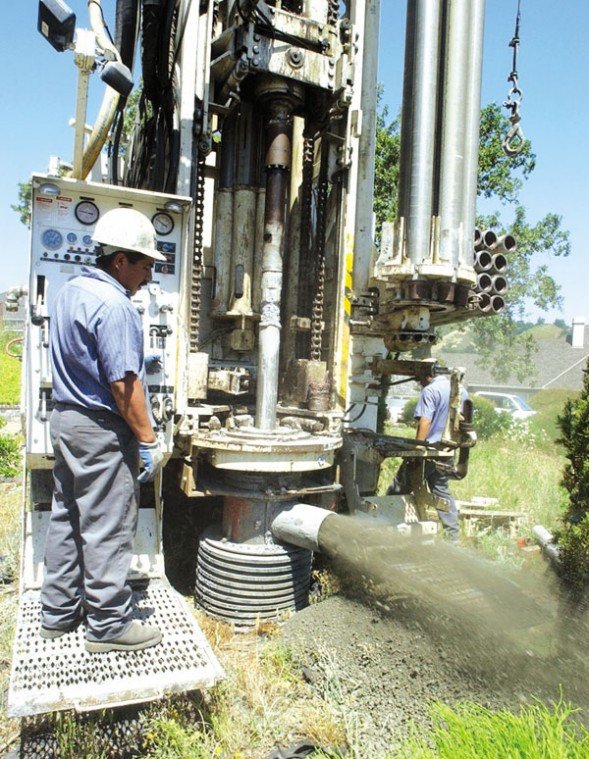For those who live too far from urban centers to receive regular
plumbing or those who do not wish to use the municipal water supply
for one reason or another, a well can be the answer.
But installing a new well can be cost-prohibitive for those
looking simply for a supplemental water supply.
For those who live too far from urban centers to receive regular plumbing or those who do not wish to use the municipal water supply for one reason or another, a well can be the answer.
But installing a new well can be cost-prohibitive for those looking simply for a supplemental water supply. Installing a new well will cost between $8,000 and $40,000 depending on soil conditions, according to local builders, but most drillers will be able to give their customers costs by the foot, an average of $40 to $50, according to Augie Guardino, general manager of Guardino Well Drilling in Morgan Hill.
“When a person calls up, and they say ‘I need a well,’ the first thing we do is establish why they need a well,” said Guardino. “Sometimes people aren’t too serious,, and they just think they’ll throw in a well for $1,000 or $2,000. When you start talking about uses, you can dissuade them pretty quickly if they’re just kicking the tires.”
The investment may seem like a bundle at the time, but it’s really one that is aimed at creating a long-term water supply, according to Dave Maggiora, president and owner of Maggiora Brothers Drilling in Watsonville and Hollister.
“We started drilling wells 42 years ago and some of the first wells we did are still going,” said Maggiora. “We’ve worked on wells that are probably close to 100 years old that are still doing fine.
“There are some areas where you can put in a well and because of the soil conditions, you’ll have a breakdown in two to three years, but not around here usually. Some areas have what we call subsidence, and that causes problems with the equipment, and some have water-quality that is so lousy that the water attacks the pipe and breaks down the well. In those cases, we just go in and case the well with plastic since the water doesn’t usually attack the plastic like it does the older metal pipe.”
Well drillers can compensate for soil conditions in most cases, according to Maggiora, but where to drill is the real question.
According to state law, wells must be located 100 feet from septic systems and livestock. Drillers also cannot place wells next to creeks or tributaries.
They do, however, attempt to place the tubes near convenient access points for power and plumbing hook-ups, and watch carefully for geological signs that water will be present.
On valley floors, such as the areas where Gilroy, Morgan Hill and Hollister are located, there is little question about hitting a water source because aquifers are fairly evenly spread out underground, but these aquifers are not evenly spread out in the foothills, according to Maggiora.
“When you get in the foothills, all your aquifers are confined to certain areas,” said Maggiora. “You go over 50 feet and you might miss one and have to start over.”
Drillers look at the typography of the land and the drilling history in the area, in order to determine whether water is present, according to Guardino.
Guardino prefers to drill at the tops of hills where he said he finds the best layering of water-filtering rock such as granite, slate and shale beneath the surface.
If no hilltop is available, he prefers a clearing or high point in the land, he said.
“A lot of people want to drill in an area because they see water running in an area or down a hillside, but what you see on top of the ground doesn’t necessarily mean that that’s what’s going to be under the ground,” said Guardino. “Good geology means that water can flow through the ground and every drilling company subscribes to different theories about what that looks like up here.”
Once the well’s position is selected, the driller must obtain a county permit to perform the drilling, but the county has the opportunity to require additional work, according to Guardino.
If an area is known to have an arsenic issue, for instance, the county may specify that a geologist be on hand at the job site in order to conduct additional testing and ensure the well is built to block the seepage of the substance, Guardino said.
It can increase the cost of a job by thousands of dollars, he said.
Permit in hand, drillers can finish a well in an average of three days between test drilling to check the area’s stability and water resources, placing the well liner and sealing the joints in the tube.
Quick projects can take as little as two days, while larger, more complicated drills may require as much as a week or more to drill using a large truck-mounted bit that can bore straight down.
For more information on drilling for your well, call Guardino Well Drilling at (408) 779-5904 or Maggiora Brothers Drilling in Watsonville at (831) 724-1338 or in Hollister at (831) 637-8228.
Questions for your driller
Installing a well is a major financial undertaking that will cost local homeowners an average of more than $10,000. Here are some questions you may consider asking before the work begins, according to Augie Guardino, general manager of Guardino Well Drilling in Morgan Hill:
• Are there any water quality issues in my area?
• How much water should I expect?
• What’s the probability of us drilling a dry hole?
• What kind of method are you going to use to drill?
• What are the details of your contract?
• Do you have references for jobs in the area?
• How long have you been in business?
• How often have you been involved in lawsuits?
• If we have problems with the geology here, do you have the equipment and the personnel to handle whatever issues crop up?
• How much space will you need?
For more information and additional resources, visit the California Groundwater Association’s Web site at www.GroundH2O.org or call (707) 578-4408.











